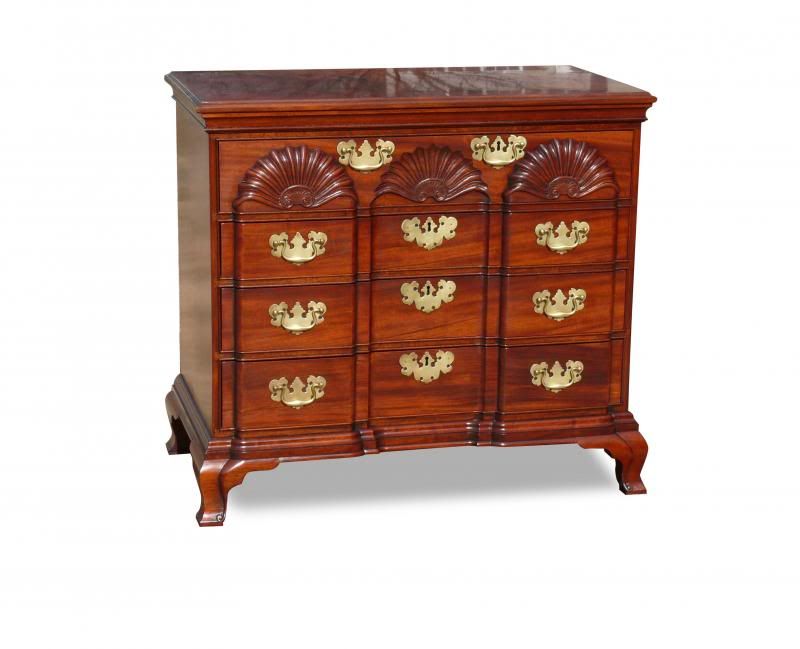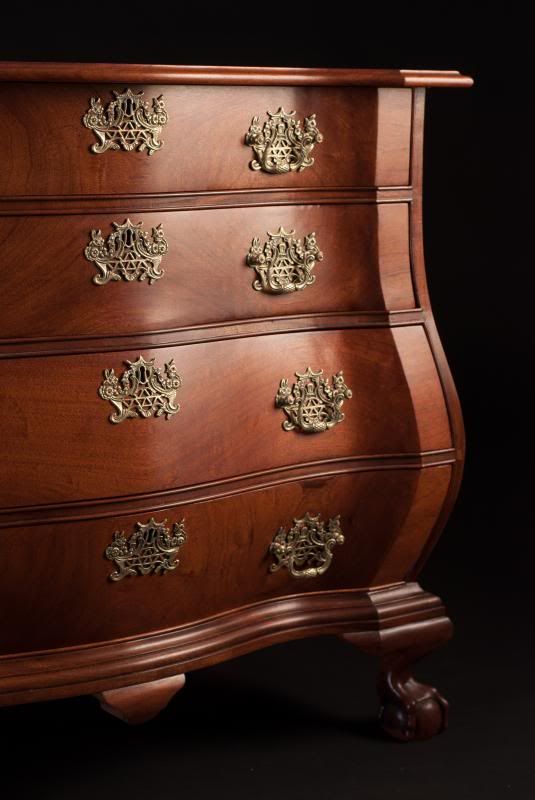Posts: 1,407
Threads: 2
Joined: Jun 2003
10-03-2017, 01:42 PM
(This post was last modified: 10-03-2017, 01:43 PM by rwe2156.)
First, check the depth of cut and iron sharpness. Depending on the species, you really can have horrible issues planing against the grain.
When laying out the drawers, I've learned to to pay attention the to grain direction of the sides and orient them going toward the back.
This way you can plane the sides all the way across front to back.
Chamfer the back corner to avoid chipping out of the pins. Even if it happens a bit it is hidden and you have nice clean sides.
On medium to large sized drawers I prefer to use a #5 LA plane.
Keep that belt sander where it belongs: hidden from sight ideally in a place you will forget about.
Hope this helps.
Posts: 11,420
Threads: 0
Joined: Dec 2002
Thanks everyone! Sacrificial block is on the menu for this weekend. Part of the problem is that I do this so rarely, and always with hand tools. That means I've become a master of making tiny shavings that can be glued and shoved into all the little gaps. And peening....
If the block works, I'll be golden.
MAKE: Void your warranty, violate a user agreement, fry a circuit, blow a fuse, poke an eye out... www.makezine.com
No Good Deed Goes Unpunished
Posts: 3,217
Threads: 0
Joined: Jan 2006
10-03-2017, 03:27 PM
(This post was last modified: 10-03-2017, 03:30 PM by Dave Diaman.)
(10-03-2017, 12:18 PM)hbmcc Wrote: Hi, Derek. Thought you were busy with work.
You being grumpy?
I think Becksvoort has assessed the commercial requirements vs amateur snobbery, and found a sander safer. I hope his finishes are smooth rather than 'orange peel' of sprayer.
]Hbmcc, I have seen you mention not liking sprayed finishes before. I’m not sure where your idea that all sprayed finishes are orange peeled or textured but nothing could be farther from the truth. Almost every professional furniture maker myself included sprays their finishes. The reason is I can get a far superior finish in a fraction of the time. I can get a fantastic finish by applying by hand but it just takes a really long time. In fact even the guys who make exact reproductions of 18th century pieces to the point of them almost being a counterfeit spray their finishes. Some of the methods for mimicking to old finishes almost have to be sprayed. You simply can’t get the proper texture and color combinations that were created by 250 years of age without it. A Good sprayed finish should look like glass. These are two of the many sprayed pieces I have built and the finish on both looks like glass.


Posts: 61
Threads: 0
Joined: Jun 2017
I'm with Derek, If you own a nice belt sander/edge sander, then go ahead and use it to trim the proud pins of a dovetail. Your customer will never know the difference.
Posts: 4,011
Threads: 0
Joined: Nov 2010
10-03-2017, 11:10 PM
(This post was last modified: 10-03-2017, 11:15 PM by bandit571.)
Just a No.4 at angle.....beltsander only if the pins are way too high. Sand down until close, then a few swipes with the smoother..
Almost like shooting end grain..this was to level out a cupped side...
Same on corner joints....the "before" shot..
Same corner

Show me a picture, I'll build a project from that
Posts: 7,008
Threads: 0
Joined: Aug 2004
Location: Perth, Australia
(10-03-2017, 12:18 PM)hbmcc Wrote: Hi, Derek. Thought you were busy with work.
You being grumpy?
I think Becksvoort has assessed the commercial requirements vs amateur snobbery, and found a sander safer. I hope his finishes are smooth rather than 'orange peel' of sprayer.
No Bruce ... just a bad joke. I was surprised, though, to see him belt sand his dovetails in the recent FWW video. I struggle to imagine how that will avoid rounding over the edges.
I always plane inwards. I used to work with a sharp, low angle jack plane. Now I like the LV Custom #7 Jointer as this has a 40 degree bed, can be set up with a closed chip breaker, and will plane into grain.
Regards from Perth
Derek
Posts: 3,217
Threads: 0
Joined: Jan 2006
I use a 2” wide paring chisel to trim my pins level. I just slice across the pins with the chisel until they are flush. Once they are flush a little hand sanding or a really sharp plane with a very,very light cut will do the trick to finish everything off.
Posts: 2,382
Threads: 0
Joined: Dec 2011
(10-04-2017, 06:39 AM)Dave Diaman Wrote: I use a 2” wide paring chisel to trim my pins level. I just slice across the pins with the chisel until they are flush. Once they are flush a little hand sanding or a really sharp plane with a very,very light cut will do the trick to finish everything off.
Set your marking gauge shy of the thickness of the stock as Ian Kirby recommends. Then plane till the blade just kisses the end grain and stop.
Simon
Posts: 2,772
Threads: 0
Joined: Oct 2012
Location: W. of Rainier, E. of Orcas
(10-03-2017, 03:27 PM)Dave Diaman Wrote: ]Hbmcc, I have seen you mention not liking sprayed finishes before. I’m not sure where your idea that all sprayed finishes are orange peeled or textured but nothing could be farther from the truth. Almost every professional furniture maker myself included sprays their finishes. The reason is I can get a far superior finish in a fraction of the time. I can get a fantastic finish by applying by hand but it just takes a really long time. In fact even the guys who make exact reproductions of 18th century pieces to the point of them almost being a counterfeit spray their finishes. Some of the methods for mimicking to old finishes almost have to be sprayed. You simply can’t get the proper texture and color combinations that were created by 250 years of age without it. A Good sprayed finish should look like glass. These are two of the many sprayed pieces I have built and the finish on both looks like glass.


No, Dave. I have no grudge against sprayed finish and wish I could use it as well. I am stuck with wiping or daubing.
If your reproduction has a glass smooth finish, fine. If not, rub it out. It does not appeal to have the cheap 'nubby' feel like that found on pricey camera bodies which is itself an imitation of leather. Some finishes may accommodate a rough feel--perhaps, Formica, solid pigment, or office use--but most don't. My phobia sprang from a bunch of 'fine' furniture in a shop that had a frosted glass look and fine sandstone feel.
I am trying to avoid the inevitable book of possible exceptions in this description.
Your work is beautiful. Thanks for sharing.
Posts: 2,772
Threads: 0
Joined: Oct 2012
Location: W. of Rainier, E. of Orcas
(10-04-2017, 12:55 AM)Derek Cohen Wrote: No Bruce ... just a bad joke. I was surprised, though, to see him belt sand his dovetails in the recent FWW video. I struggle to imagine how that will avoid rounding over the edges.
I always plane inwards. I used to work with a sharp, low angle jack plane. Now I like the LV Custom #7 Jointer as this has a 40 degree bed, can be set up with a closed chip breaker, and will plane into grain.
Regards from Perth
Derek
Hah! It must be "the way they used to make them." I believe Becksvoort said his sander has been around since he first started. A pro in Seattle mentioned the same thing about hanging onto her old belt sander.
Maybe, they don't round corners like the new stuff. I still have a preference for my circular saw, which I have used longer than the RAS. It feels safer when ripping.
|







